
Packaging manufacturer Ball (NYSE:BLL) missed Wall Street’s revenue expectations in Q4 CY2024, with sales falling 15.4% year on year to $2.88 billion. Its non-GAAP profit of $0.84 per share was 3.7% above analysts’ consensus estimates.
Is now the time to buy Ball? Find out by accessing our full research report, it’s free.
Ball (BALL) Q4 CY2024 Highlights:
- Revenue: $2.88 billion vs analyst estimates of $2.94 billion (15.4% year-on-year decline, 1.9% miss)
- Adjusted EPS: $0.84 vs analyst estimates of $0.81 (3.7% beat)
- Operating Margin: 16%, up from 8.8% in the same quarter last year
- Free Cash Flow Margin: 13.6%, down from 15.3% in the same quarter last year
- Market Capitalization: $16.62 billion
"We delivered strong full-year and fourth quarter results and returned $1.96 billion to shareholders in 2024. Leveraging our strong financial position and leaner operating model, the company was able to deliver on its 2024 goals and remains uniquely positioned to enable our purpose of advancing the greater use of sustainable aluminum packaging, despite the current end consumer environment in certain geographies. We continue to complement our purpose by unlocking additional manufacturing efficiencies, driving innovation and sustainability on a global scale, managing our costs and enabling consistent delivery of high-quality, long-term shareholder value creation," said Daniel W. Fisher, chairman and chief executive officer.
Company Overview
Started with a $200 loan in 1880, Ball (NYSE:BLL) manufactures aluminum packaging for beverages, personal care, and household products as well as aerospace systems and other technologies.
Industrial Packaging
Industrial packaging companies have built competitive advantages from economies of scale that lead to advantaged purchasing and capital investments that are difficult and expensive to replicate. Recently, eco-friendly packaging and conservation are driving customers preferences and innovation. For example, plastic is not as desirable a material as it once was. Despite being integral to consumer goods ranging from beer to toothpaste to laundry detergent, these companies are still at the whim of the macro, especially consumer health and consumer willingness to spend.
Sales Growth
Reviewing a company’s long-term sales performance reveals insights into its quality. Any business can have short-term success, but a top-tier one grows for years. Unfortunately, Ball struggled to consistently increase demand as its $11.8 billion of sales for the trailing 12 months was close to its revenue five years ago. This fell short of our benchmarks and is a sign of poor business quality.
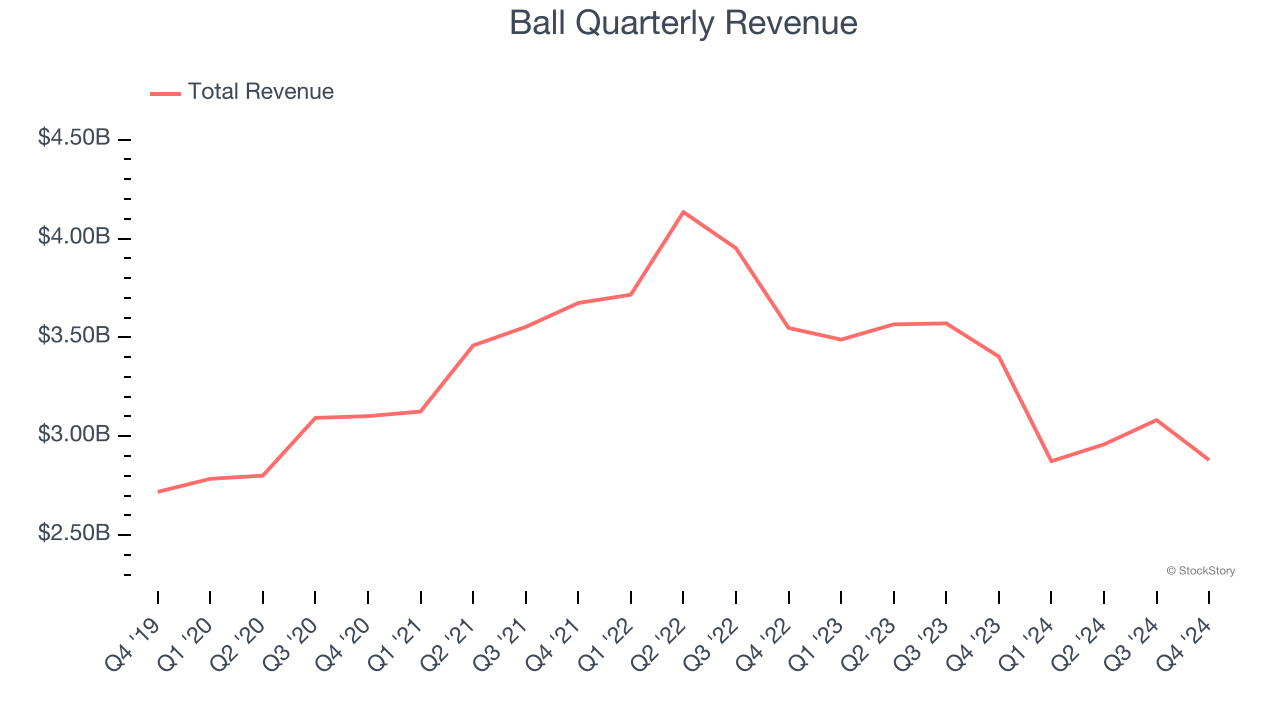
Long-term growth is the most important, but within industrials, a half-decade historical view may miss new industry trends or demand cycles. Ball’s recent history shows its demand has stayed suppressed as its revenue has declined by 12.3% annually over the last two years. Ball isn’t alone in its struggles as the Industrial Packaging industry experienced a cyclical downturn, with many similar businesses observing lower sales at this time. 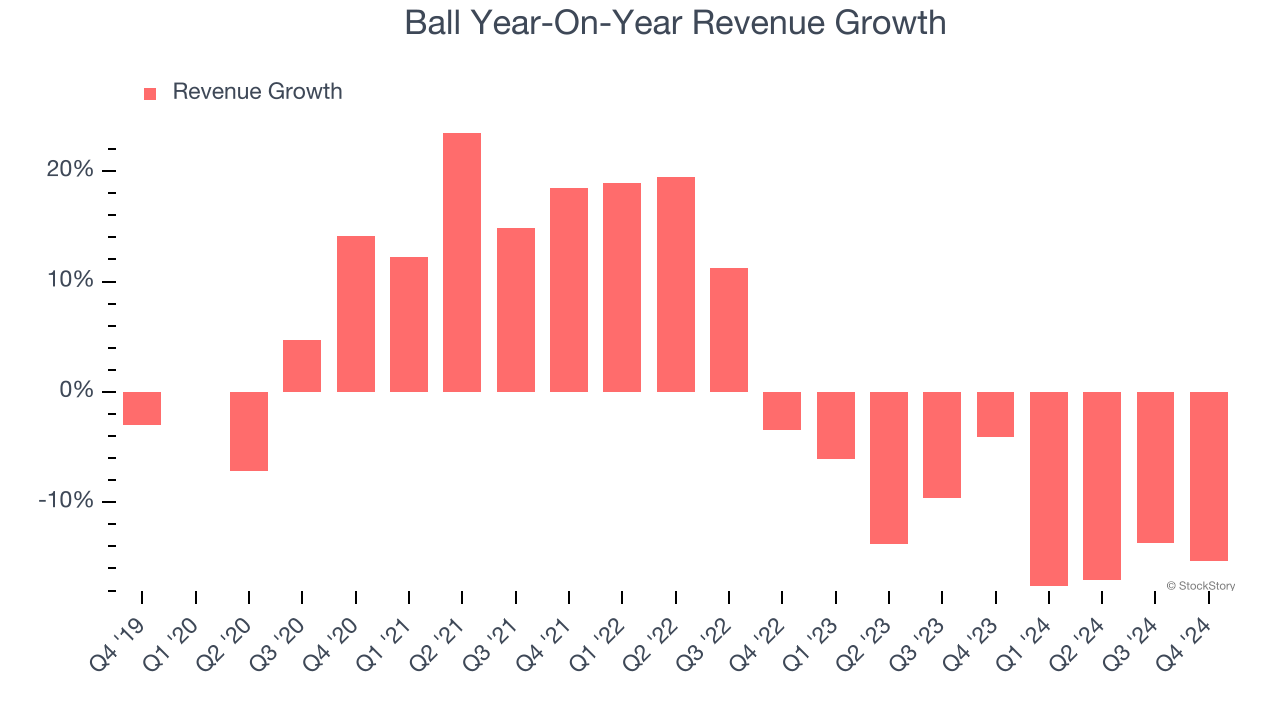
This quarter, Ball missed Wall Street’s estimates and reported a rather uninspiring 15.4% year-on-year revenue decline, generating $2.88 billion of revenue.
Looking ahead, sell-side analysts expect revenue to grow 3.1% over the next 12 months. While this projection implies its newer products and services will spur better top-line performance, it is still below average for the sector.
Unless you’ve been living under a rock, it should be obvious by now that generative AI is going to have a huge impact on how large corporations do business. While Nvidia and AMD are trading close to all-time highs, we prefer a lesser-known (but still profitable) stock benefiting from the rise of AI. Click here to access our free report one of our favorites growth stories.
Adjusted Operating Margin
Operating margin is an important measure of profitability as it shows the portion of revenue left after accounting for all core expenses – everything from the cost of goods sold to advertising and wages. It’s also useful for comparing profitability across companies with different levels of debt and tax rates because it excludes interest and taxes.
Ball has done a decent job managing its cost base over the last five years. The company has produced an average operating margin of 8.9%, higher than the broader industrials sector.
Looking at the trend in its profitability, Ball’s operating margin rose by 1.6 percentage points over the last five years, showing its efficiency has improved.
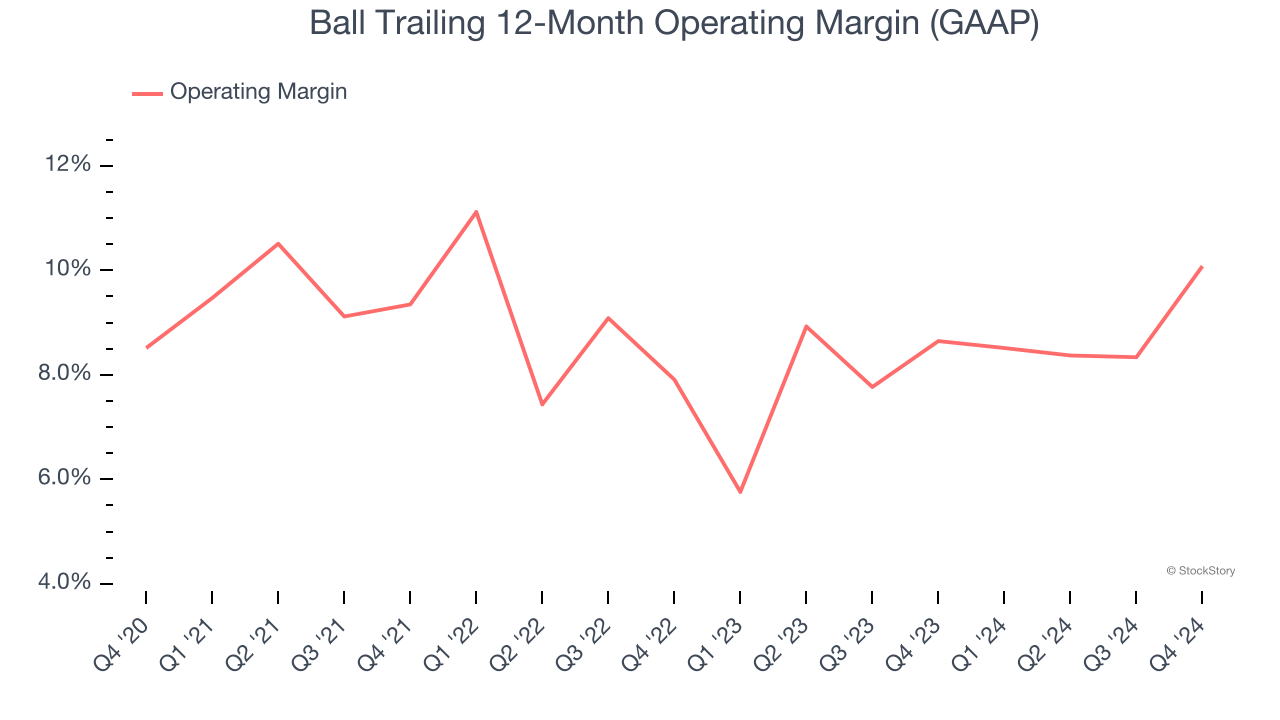
In Q4, Ball generated an operating profit margin of 16%, up 7.2 percentage points year on year. The increase was solid, and since its operating margin rose more than its gross margin, we can infer it was recently more efficient with expenses such as marketing, R&D, and administrative overhead.
Earnings Per Share
We track the long-term change in earnings per share (EPS) for the same reason as long-term revenue growth. Compared to revenue, however, EPS highlights whether a company’s growth is profitable.
Ball’s EPS grew at an unimpressive 4.6% compounded annual growth rate over the last five years. On the bright side, this performance was better than its flat revenue and tells us management responded to softer demand by adapting its cost structure.
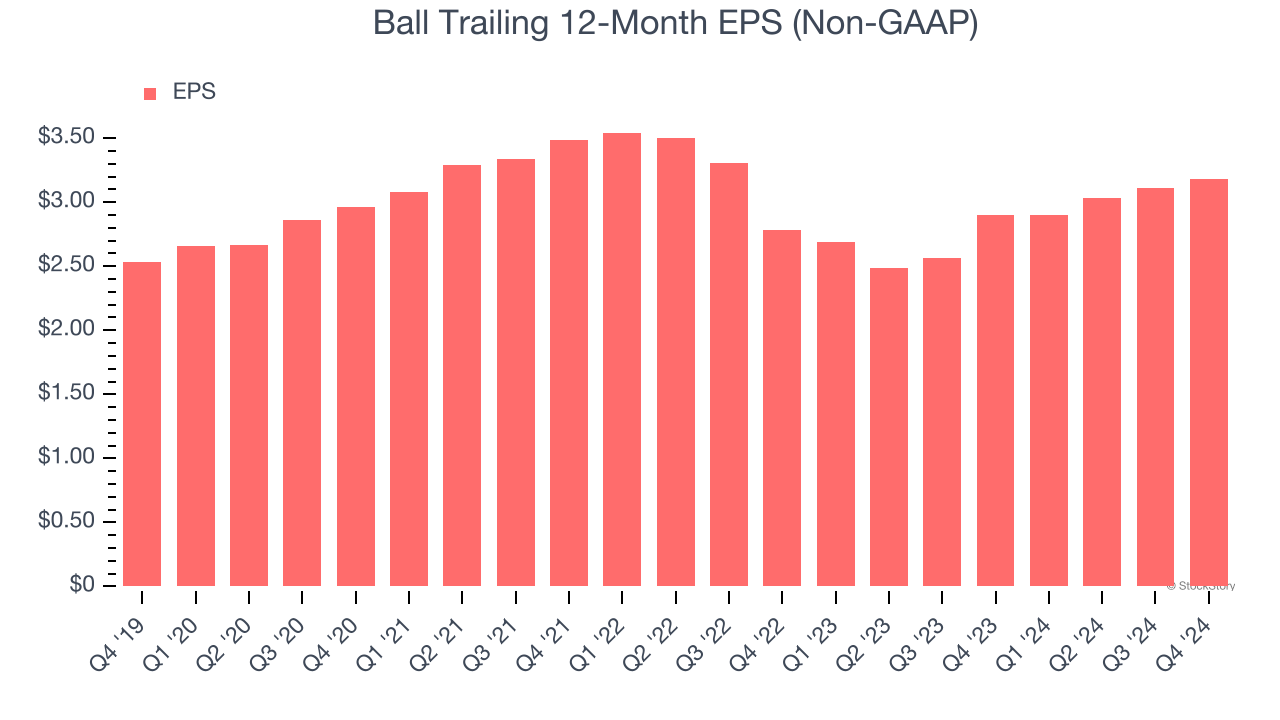
We can take a deeper look into Ball’s earnings to better understand the drivers of its performance. As we mentioned earlier, Ball’s operating margin expanded by 1.6 percentage points over the last five years. On top of that, its share count shrank by 11.8%. These are positive signs for shareholders because improving profitability and share buybacks turbocharge EPS growth relative to revenue growth. 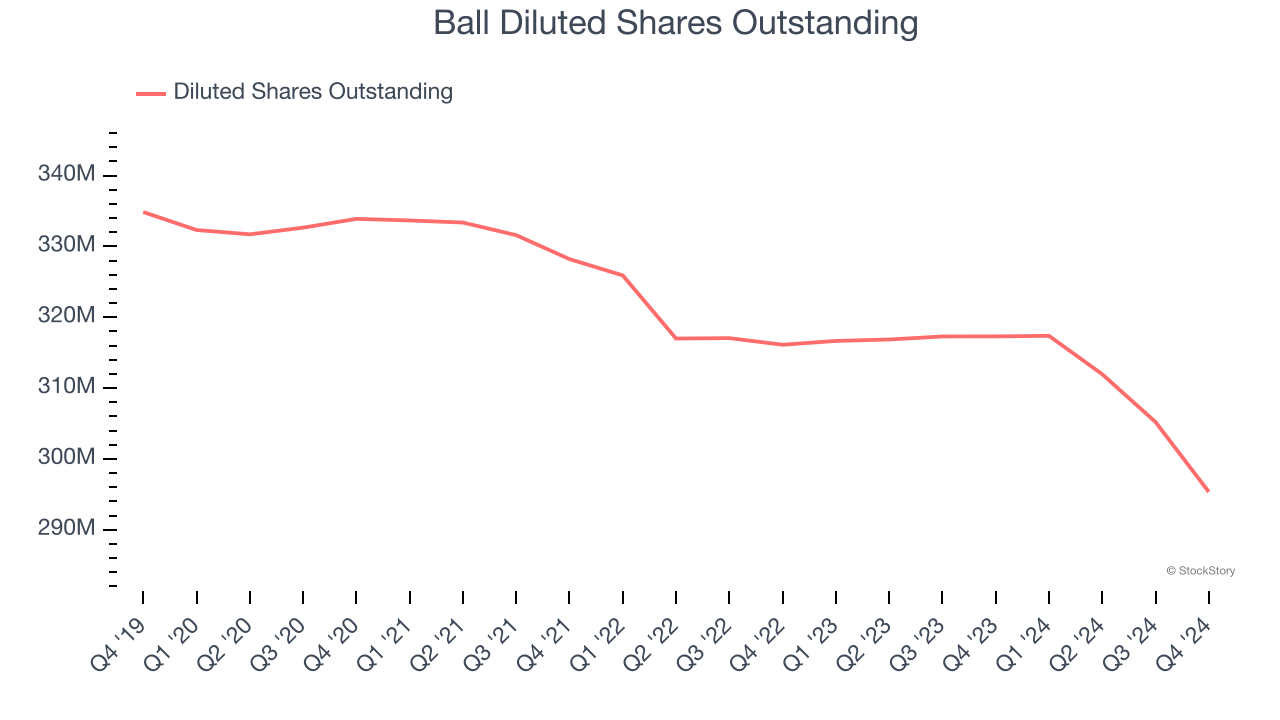
Like with revenue, we analyze EPS over a shorter period to see if we are missing a change in the business.
For Ball, its two-year annual EPS growth of 6.9% was higher than its five-year trend. Accelerating earnings growth is almost always an encouraging data point.
In Q4, Ball reported EPS at $0.84, up from $0.78 in the same quarter last year. This print beat analysts’ estimates by 3.7%. Over the next 12 months, Wall Street expects Ball’s full-year EPS of $3.18 to grow 10.9%.
Key Takeaways from Ball’s Q4 Results
We liked that Ball's EPS outperformed Wall Street’s estimates. On the other hand, its revenue missed. Zooming out, we think this quarter was mixed. The stock traded down 1.2% to $55.05 immediately following the results.
So should you invest in Ball right now? We think that the latest quarter is only one piece of the longer-term business quality puzzle. Quality, when combined with valuation, can help determine if the stock is a buy. We cover that in our actionable full research report which you can read here, it’s free.














